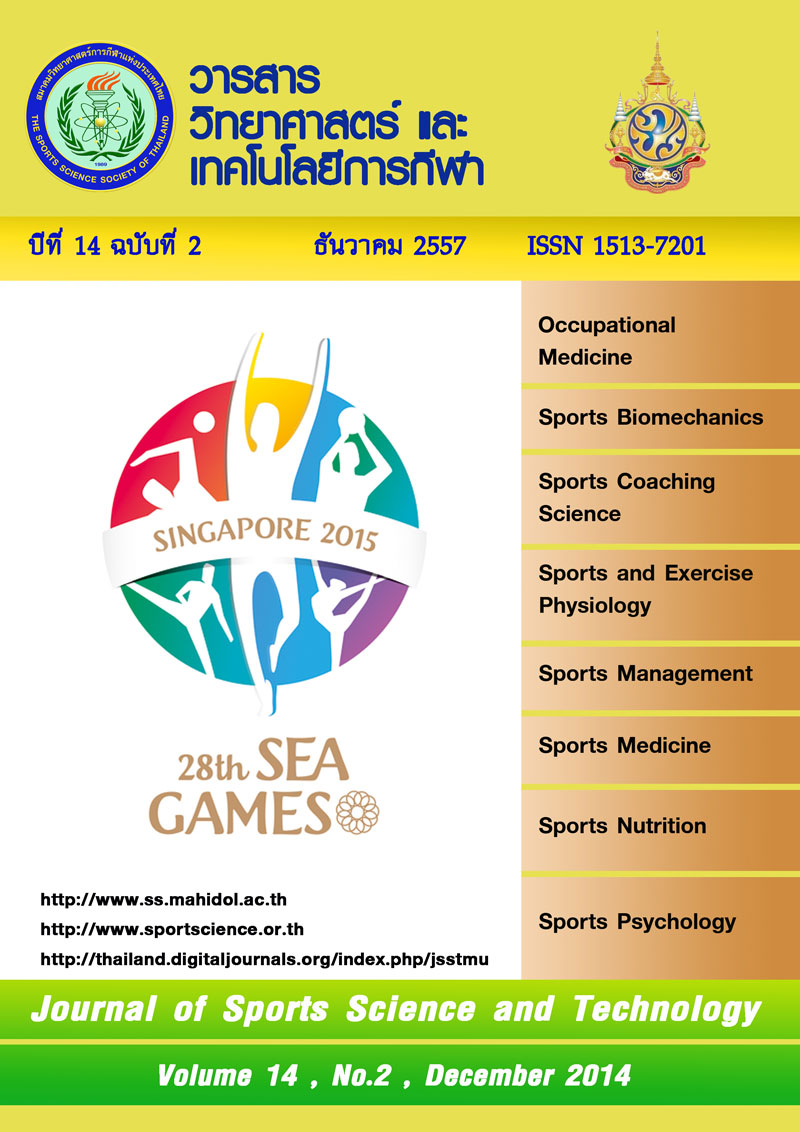WATER INTAKE ON CARDIORESPIRATORY FUNCTION DURING CONSTANT LOAD EXERCISE UNDER HYPOXIC CONDITION
Keywords:
Water Intake, Hypoxic Condition, Exercise, Cardiorespiratory VariablesAbstract
Water Intake on Cardiorespiratory Function during Constant Load Exercise under Hypoxic Condition
Matinee Phangjaem*, Waree Vidjaja, Metta Pinthong and Rungchai Chaunchaiyakul
College of Sports Science and Technology, Mahidol University, Thailand
Objective: The aim of this study was to identify the effect of without and with water intake on cardiorespiratory function responses to exercise under hypoxic conditions in physically active males.
Method: Nine physically active males (age: 18-22 yrs) voluntarily participated in three trials study: started with exercise under normoxic condition (NOR) to quantitate amount of water loss form 70% O2max, followed by two trials of hypoxic condition (15% inspired O2) exercise under same protocol without (HOW) and with (HWW) water intake equivalent to the same percentage of predetermined water loss. Exercise was conducted on a cycle ergometer at constant load on individual basis of predetermined workload – induced 70% O2max. Cardiorespiratory variables including heart rate (HR), stroke volume (SV), cardiac output (), oxygen saturation (SpO2), respiratory rate (RR), minute ventilation (E), tidal volume (VT), with additional oxygen consumption (O2), carbon dioxide production (CO2), and rating of perceived exertion (RPE) were collected at rest, during exercise at 20, 40 and 60 min, and every five min interval recovery period.
Results: Exercises under NOR and HOW conditions induced weight loss of 1.4 and 1.19% of body weight respectively. Therefore, water intake of 1.19% of body weight was sequentially sipped during HWW condition. Cardiac variables including HR, SV, showed no significant difference between groups. Within group comparison showed significant increasing HR, SV, from initial value at 20, 40 and 60 min of exercise and at 5, 10 and 15 min of recovery (p<0.05). Respiratory variables including RR and VT showed no significant difference between groups with the exception of E where HWW has significantly higher than NOR (p<0.05). Increasing E in HWW group was most likely compensated by increasing RR while VT was kept constant. Within group comparison showed significant difference of RR, VT, E from initial value throughout the entire period of the study (p<0.05). We additionally explored metabolic and subjective variables. Data showed that no significant difference of these variables for between-groups comparison. Within-group comparison revealed significant difference.
Conclusion: Exercise under hypoxic condition with water intake offers greater air ventilation. The compensation is likely due to achieving higher VT with reflects ability of lung expansion. The underlying mechanism may be either humidity or lower temperature in the lung.
Keywords: Water Intake, Hypoxic Condition, Exercise, Cardiorespiratory Variables
*Corresponding author: Contact Address kwang_sn41@hotmail.com





